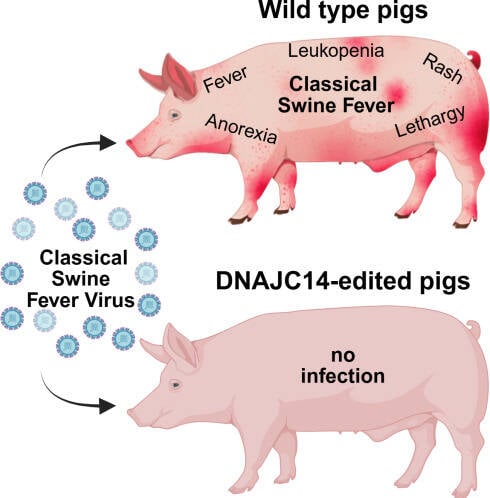I’ve come across multiple iterations of this Facebook meme.
Several cars sit half-buried as a snowstorm rages around them. The caption reads something like, “Can you imagine an electric vehicle stuck here for hours, the battery dying, the saps inside freezing their patooties off? Pry my gas-powered vehicle from my cold, dead hands!”
For everyone whose cell battery has died on a cold day, it’s reasonable to ask if electric vehicles – EVs, as aficionados say – can safely transport your family across rural Manitoba.
Read Also

Gene editing against classical swine fever
British scientists have discovered a gene edit that could provide resistance to classical swine fever in pigs and bovine viral diarrhea in cattle
These are questions that become even more relevant, but also more divisive, in today’s political landscape.
A couple days before Christmas, Steven Guilbeault, Minister of Environment and Climate Change, rolled out proposed regulations that would set zero-emission vehicle (ZEV) sales targets for manufacturers and importers. ZEVs include EVs, plug-in hybrids and hydrogen fuel cell vehicles.
The draft regulations would require at least 20 per cent of new vehicles sold in Canada to be ZEVs by 2026, rising to 60 per cent by 2030 and 100 per cent by 2035. According to a government news release, about seven per cent of new “light-duty vehicles” registered in the first half of 2022 were ZEVs.
I’ve heard it said that this makes sense for city folk but for rural and farm families, is that possible? Is that safe? Those are fair questions, especially if, like me, you’ve never sat inside an EV.
What works
I met with Mike Loewen in a truck stop A&W one bitterly cold day this December.
Loewen is a retired pilot and Transport Canada safety inspector, and a co-founder of the Manitoba Electric Vehicle Association. He lives just outside Winnipeg.
I parked my faded Toyota hatchback beside his shiny Hyundai Ioniq 5 and, after yakking inside for an hour, he invited me for a test drive.
The Ioniq was eerily quiet. When Mike pressed the start button, I wasn’t sure anything had happened. When I accelerated onto the Trans-Canada Highway, the only sound was the crunch of snow beneath the wheels.
Mike fiddled with the settings, increasing the level of regenerative braking, in which the car reclaims kinetic energy as it slows. At 100 per cent regenerative braking, the driver can control the car with only the accelerator.
While the idea of recycling braking energy was appealing, it took some getting used to in practice. I panic-hit the “real” brakes a couple of times.
The Ioniq is Mike’s third EV. His first, a 2011 Nissan Leaf, is still on the road. The two cars provide a good comparison.
New, the Leaf could only travel about 160 kilometres per charge, Mike said. Over the last decade, it’s lost a bit of range and is now able to do about 100 km in summer and 75 km in winter.
The Ioniq has a range just over 350 km to nearly 490 km per charge, depending on the model, Hyundai’s website says. It’s a bit less in winter, Loewen said.
EVs lose range in the winter. That’s true. Keeping the battery and the cabin warm are factors.
Steinbach resident Kyle Penner said his Tesla Model 3’s range is nearly halved in winter, from 380 to 200 km per charge.
That’s fine for his family’s lifestyle, he added. They took an inventory of their driving habits before purchasing and determined they’d rarely drive further.
Ron Friesen, a farmer from Rosenort, drives a 2016 Tesla Model S. It does about 430 km per charge, but he estimated the vehicle lost about 40 per cent of its range in winter.
Friesen said he had a scare one cold day on a round trip from Rosenort to Steinbach and Winnipeg. The Tesla had sat unplugged for a couple of hours. On the way home, he had to slow to 70 km/h and lower the heat.
To my knowledge, there’s no public EV charger in Steinbach.
The Tesla will indicate when it doesn’t have sufficient charge to make its destination and will give a route to the nearest public charger, Penner said.
On the beaten path, this isn’t a big issue. Penner and Friesen both said they’d taken their EVs on road trips and found chargers at regular intervals on the Trans-Canada Highway. On a trip to Regina, charging added about an hour to the trip each way but saved about $75 compared to gas.
“If you were to tell me, ‘hey Kyle, I’ll pay you $75 to sit in the car for an hour’, I think most of us would do that,” he said.
Get off the Trans-Canada and public chargers become scarce. Databases like ChargeHub showed no public chargers in the southwest or extreme southeast corners of the province, and nothing farther north than Gimli.
As part of its proposed ZEV regulations, the government of Canada has pledged to build around 85,000 public charging stations said Ekta Bibra, senior policy advisor with Clean Energy Canada.
About 80 to 90 per cent of all EV charging happens at home, Bibra said. The EV drivers I spoke to confirmed this. EVs can also charge, albeit very slowly, through a conventional plug.
I’d conclude that for many rural residents, electric vehicles would be feasible even in winter. For more remote areas, however, it could be dicey.
Bibra reminded me that the government’s definition of “ZEV” includes plug-in hybrids, which have both electric and gas-powered engines.
“It doesn’t have to be a full-fledged EV,” she said.
What doesn’t work (yet?)
Pickup trucks may be a pinch-point for a rural EV market. There are EV pickups available, like the Ford F-150 Lightning. Chevy’s Silverado EV is slated to become available in late 2023.
However, towing and battery life don’t play well, Mike told me.
According to an August 2022 Car and Driver article, the 2023 F-150 Lightning has a range of 161 km when towing a 6,100-pound (2,770 kg) camping trailer at 112 km/h. That’s less than half of its non-towing range, and this was on a warm day.
EVs are also hard to get. Canada has had an EV shortage for years, Bibra said.
Automakers are prioritizing B.C. and Quebec, which already have regulated ZEV targets. Even so, people can wait six to eight months for an EV, Bibra said. In Manitoba, the wait is likely longer.
Federal ZEV sales regulations will be helpful for increasing overall supply and the range of models, Bibra said.
Automakers are “not mass-producing more affordable electric vehicles. They’re just focusing right now on selling luxury electric vehicles.”
Sales regulations would incentivize production of mass marketed, affordable EVs, Bibra said.
Others were less optimistic.
The government can’t “regulate away global supply chain challenges,” Brian Kingston told CTV News. Kingston is president and CEO of the Canadian Vehicle Manufacturers’ Association. He suggested the Canadian government should build out infrastructure before regulating sales.
“The vehicles are coming, but we need a supercharged effort to help marketing, and actually make that purchase and make it easy, convenient and accessible,” he told CTV.
But they are cool
I admit that when I got out of the Ioniq and back into my Toyota, I wanted an EV. For one thing, I never want to go to a gas station again. Plugging in when I get home sounds like a dream.
However, it’s clear that EVs come with challenges, chiefly supply and infrastructure right now. These are issues that shouldn’t be ignored or downplayed by EV enthusiasts. However, for many people, EVs (and ZEVs, more broadly) are feasible options.
Perhaps a measured approach, not a meme approach, is needed.
















